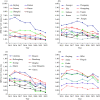Temporal and Spatial Trends in HIV Positivity Rate for VCT Clinics - China, 2015-2022
- PMID: 38223658
- PMCID: PMC10787340
- DOI: 10.46234/ccdcw2024.002
Temporal and Spatial Trends in HIV Positivity Rate for VCT Clinics - China, 2015-2022
Abstract
Introduction: Human immunodeficiency virus (HIV) voluntary counseling and testing (VCT) clinics play a critical role in identifying and diagnosing HIV cases. This study aimed to describe the trend of HIV positivity rate (HPR) among Chinese VCT clinics between 2015 and 2022.
Methods: This study utilized data from the China Information System for Disease Control and Prevention to analyze the trend in the HPR for VCT clinics from 2015 to 2022. The HPR was calculated by dividing the number of newly-reported HIV cases by the number of HIV tests, multiplied by 100%. To identify temporal and spatial trends in the HPR, we employed joinpoint regression analysis and the Getis-Ord hotspot analysis.
Results: From 2015 to 2022, VCT clinics in China performed a total of 22,075,386 HIV tests, leading to the identification of 260,353 HIV cases, resulting in a HPR of 1.18%. The HPR consistently declined over the study period, with an average annual percent change (AAPC) of -7.5% (95% confidence interval: -12.6%, -2.2%, P<0.05). The number of HPR hotspots also decreased from 41 in 2015 to 23 in 2022. These HPR hotspots were primarily located in Yunnan, Sichuan, Guangdong, and Guangxi provincial-level administrative divisions (PLADs). Among the 31 PLADs, 16 showed a significant decrease in HPR during the study period (AAPC<0, PAAPC<0.05).
Conclusions: VCT clinics in China have played a significant role in identifying HIV cases. The declining HPR observed in these clinics may indicates the progress has been made in some degree in mitigating HIV among high-risk populations. Therefore, it is crucial to further improving the utilization of VCT clinics for HIV testing.
Keywords: HIV; VCT; trend.
Copyright and License information: Editorial Office of CCDCW, Chinese Center for Disease Control and Prevention 2024.
Conflict of interest statement
No conflicts of interest.
Figures
Similar articles
-
Repeat HIV Testing and Incident Rates among Individuals Attending Voluntary Counseling and Testing Clinics in Wuxi, China: A Retrospective Study.Biomed Environ Sci. 2018 Jan;31(1):37-47. doi: 10.3967/bes2018.004. Biomed Environ Sci. 2018. PMID: 29409583
-
Internet-facilitated, voluntary counseling and testing (VCT) clinic-based HIV testing among men who have sex with men in China.PLoS One. 2013;8(2):e51919. doi: 10.1371/journal.pone.0051919. Epub 2013 Feb 13. PLoS One. 2013. PMID: 23418417 Free PMC article.
-
HIV Prevalence and Factors Influencing the Uptake of Voluntary HIV Counseling and Testing among Older Clients of Female Sex Workers in Liuzhou and Fuyang Cities, China, 2016-2017: A Cross-Sectional Study.Biomed Res Int. 2020 Feb 20;2020:9634328. doi: 10.1155/2020/9634328. eCollection 2020. Biomed Res Int. 2020. PMID: 32185227 Free PMC article.
-
Survey of motivation for use of voluntary counseling and testing services for HIV in a high risk area of Shenyang, China.BMC Health Serv Res. 2009 Feb 5;9:23. doi: 10.1186/1472-6963-9-23. BMC Health Serv Res. 2009. PMID: 19196456 Free PMC article.
-
Voluntary counseling, testing, and referral for HIV: new technologies, research findings create dynamic opportunities.J Acquir Immune Defic Syndr. 2000 Dec 15;25 Suppl 2:S128-35. doi: 10.1097/00042560-200012152-00007. J Acquir Immune Defic Syndr. 2000. PMID: 11256733 Review.
References
-
- Han MJ, Chen QF, Xu P, Shi Y Forging ahead in the thirteenth five-year plan: a review and prospects of HIV/AIDS prevention and control in China. Chin J AIDS STD. 2021;27(12):1327–31. doi: 10.13419/j.cnki.aids.2021.12.01. - DOI
-
-
The State Council of the People’s Republic of China. Chinese 12th Five-Year Plan for HIV/AIDS Prevention and Control. https://www.gov.cn/gongbao/content/2012/content_2084242.htm. [2023-9-20]. (In Chinese).
-
-
- Wang HX, Xu J, Zang CP HIV/AIDS cases detection in medical institutions from 2016 to 2021 in China. Chin J AIDS STD. 2023;29(2):157–60. doi: 10.13419/j.cnki.aids.2023.02.07. - DOI
LinkOut - more resources
Full Text Sources

